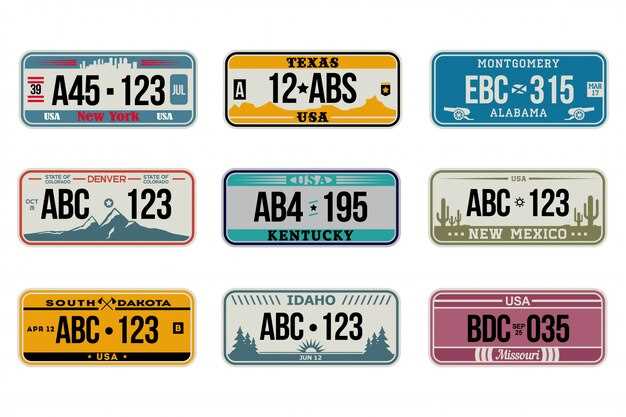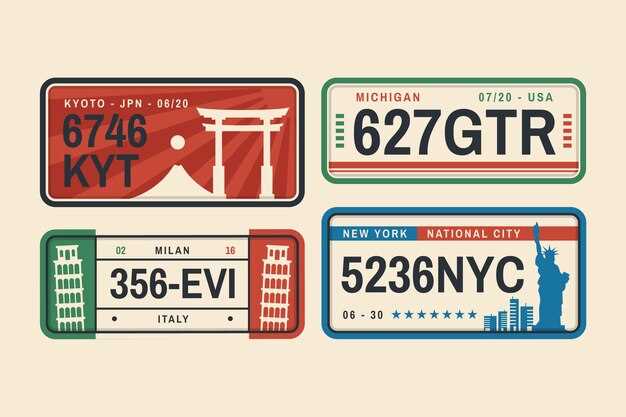
The Middle East is a region rich in cultural diversity and historical significance, and this diversity is reflected not only in its traditions and languages but also in the formats of license plates used across various countries. Each nation follows specific regulations regarding vehicle registration and identification, which are often influenced by local customs, administrative practices, and even security concerns.
Understanding the various license plate formats in countries like Saudi Arabia, the United Arab Emirates, and Jordan provides valuable insight into the region’s regulatory frameworks and the importance of vehicle identification. In many cases, these formats can reveal not just the origin of the vehicle, but also information about the owner, vehicle type, and registration details.
License plates in the Middle East are typically characterized by a combination of letters and numbers, often accompanied by distinctive colors or designs that signify governmental authority or special classifications. For example, some nations have introduced personalized plates that cater to individual preferences, showcasing a blend of tradition and modernity. Understanding these formats is essential for anyone looking to navigate or understand the intricate web of vehicle regulations within the region.
Standard Variations in License Plate Design for Different Countries
License plate designs vary significantly across the countries in the Middle East, reflecting cultural, historical, and administrative differences. Each country has established its own set of standards that influences the format, color, and layout of license plates.
United Arab Emirates plates typically feature a white background for private vehicles, complemented by a bold black font. Commercial vehicles often sport a yellow background. Each plate includes a numerical code followed by a unique identifying number, accommodating a mix of Arabic and English characters.
Saudi Arabia employs a standard rectangular plate design with a white base for civilian vehicles. The Arabic script is prominently displayed, accompanied by a numerical sequence below. The design incorporates a green stripe that symbolizes the country’s flag and national identity.
Qatar utilizes a white background for private vehicles and a yellow background for commercial uses. License plates display both Arabic and English inscriptions. The numbering format generally includes a unique five-digit code, followed by a two-letter identification for vehicle type.
Bahrain features plates that showcase a distinctive red background in addition to white plates for public vehicles. The numbers are arranged in a manner that prioritizes visibility and clarity, with Arabic letters often used alongside English numerals.
Kuwait has a unique system where personal vehicles sport white plates with a blue border, while commercial vehicles have yellow plates. The Arabic numeral system plays a central role, and plates often include a regional code indicating the area of registration.
Oman also employs a straightforward white backdrop for personal plates, with a contrasting color for commercial vehicles. The license plate format incorporates a four-digit number, which is designed for easy recognition in traffic.
Iraq license plates depict a mix of Arabic numerals and English letters, often with a blue-green background. The format differs across regions, reflecting local administrative practices.
In summary, while the core functions of license plates remain consistent–identifying vehicles–the visual representation, formats, and specific regulations differ markedly across Middle Eastern countries. These variations not only serve functional purposes but also highlight each nation’s unique identity and heritage.
Key Regulatory Requirements for Vehicle Registration in the Region

Vehicle registration in the Middle East varies significantly across countries, influenced by local laws, regulations, and bureaucratic practices. However, several key regulatory requirements are commonly found across the region.
1. Proof of Ownership: To register a vehicle, individuals must provide valid proof of ownership, which can include purchase agreements, invoices, or bills of sale. This documentation ensures that the applicant is the legitimate owner of the vehicle and has the right to register it.
2. Identification Documents: Registrants must present valid identification documents. Typically, a national ID, passport, or residency permit is required to verify the identity of the individual applying for vehicle registration.
3. Vehicle Insurance: Most countries in the region mandate that vehicles be insured before they can be registered. Proof of insurance must be submitted, ensuring that the vehicle meets minimum insurance coverage requirements established by local authorities.
4. Technical Inspection: Many jurisdictions require a technical inspection of the vehicle prior to registration. This inspection assesses the vehicle’s roadworthiness and compliance with safety and environmental regulations. Certificates from approved inspection facilities must be provided.
5. Fees and Taxes: Vehicle registration typically involves various fees, including registration fees, road taxes, and sometimes additional charges based on the vehicle’s type or size. Payment of these fees is necessary for the completion of the registration process.
6. Emission Standards Compliance: To address environmental concerns, certain countries require vehicles to meet specific emission standards. Documentation proving compliance may be necessary, particularly for newer models or diesel vehicles.
7. Renewal Requirements: Vehicle registration is not a one-time process. Most countries require periodic renewal, which may involve re-submitting documentation, paying fees, and completing inspections to ensure continued compliance with regulatory standards.
Understanding these key regulatory requirements is essential for vehicle owners in the Middle East to ensure a smooth registration process and compliance with local laws and regulations.
Identification of Vehicle Types through License Plate Coding Systems

License plate coding systems in the Middle East are designed not only for vehicle registration but also for the identification of different vehicle types. Each country has its own unique coding structure that helps authorities quickly determine the classification of vehicles based on their license plate numbers.
Categories of Vehicles
Typically, vehicle classifications include private cars, commercial vehicles, motorcycles, and government or diplomatic vehicles. In many countries, specific prefixes or unique character arrangements indicate these categories. For example, in the United Arab Emirates, certain numbers or letters may signify commercial transport, while others may be reserved for personal use.
Color Coding and Symbols
In addition to alphanumeric codes, some license plates feature specific colors or symbols that provide immediate recognition of the vehicle’s type. For instance, in Saudi Arabia, government vehicles utilize distinctive formats and colors that differentiate them from civilian vehicles. This system allows law enforcement and the public to easily identify authorized government transportation.
Regional Variations
Different nations implement specific regulations that affect license plate formats. In Qatar, specific characters are allocated to distinguish between various vehicle types. Similarly, in Oman, distinct series of letters may indicate commercial or military vehicles, ensuring that registration authorities maintain clarity in vehicle classification.
Implications for Law Enforcement
The identification of vehicle types through these coding systems is crucial for law enforcement and traffic management. Officers can quickly ascertain the nature of a vehicle during routine checks, which aids in identifying potential fraudulent activities or unauthorized vehicles. Additionally, emergency response teams may rely on coding systems to prioritize actions based on the type of vehicle involved in incidents.
Technological Integration
With advancements in technology, many Middle Eastern countries are integrating automated systems that read license plate codes to enhance vehicle identification processes. High-definition cameras and AI-driven software can efficiently classify vehicles in real time, contributing to improved traffic flow and safety on the roads.
In conclusion, the structured coding systems used in license plates in the Middle East serve a vital role in categorizing vehicle types. These systems facilitate efficient management and regulation of road traffic while supporting law enforcement efforts across the region.
